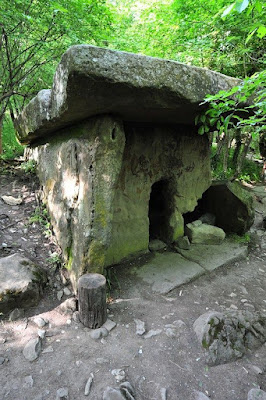“In the North-West Caucasus, from Abkhazia the Taman Peninsula, are thousands of ancient dolmens which the locals call ‘ispun’, meaning the ‘houses of dwarves’. The megalithic structures were built during the early Bronze Age, from the middle of the 4th millennium BC to the end of the 2nd millennium BC. Dolmen construction consisted of a chamber built from several precisely dressed connected stone blocks, or were ca(r)ved in a rock mass. A large roof slab covered the chamber, whilst an access portal was formed by projecting blocks from the side walls and the overhanging roof slab. Most dolmens are punctuated with either a square, semi-circular, or oval access porthole in the centre of the façade, and can be specified into four basic types; slab, built-up, semi-monolithic and monolithic, with a typical floor plan that is square, trapezoidal, rectangular, and round.” (HeritageDaily 2021)
A very strange 2013 paper by Sharikov et. al. on the creation of these dolmen (see below) purports to prove that they were constructed without physical stone carving technology by casting fluids in molds that then hardened into the stone. Introduced by J. Davidovitz of his Geopolymer Institute, his application of fluidics was originally intended to prove that the blocks of stone in the pyramids of Giza in Egypt were cast, not carved from a quarry. This would be the Bronze Age equivalent of the site-cast concrete buildings of modern business parks where a wall, floor, or other component is cast horizontally on the ground out of reinforced concrete and then hoisted into place with preset, and carefully premeasured, steel components meeting upon erection to allow welding, riveting, or bolting them together to hold everything in place.
“There are raised patterns (petroglyphs) on the face slabs of some dolmens. To obtain such a relief, the builders would have to grind off the layer from the whole surface of the face slab. However the bas-relief is made very accurately. The stone surface is smooth and has no traces of stone working. The work on the creation of the bas-reliefs is very labor intensive and involves the use of very sophisticated stone working technology and special equipment.” (Sharikov et. al. 2013: 41) I do not understand why, if the slabs used in these constructions were cast from special fluids, why the patterns would not have just been cast in place instead of having to subsequently carve them. In other words, if you are making a mold to cast the whole wall in one piece why not modify the surface of the mold to create the pattern you want?
The team found “proof” of the fluid origin of the rock in the appearance of a carbonized tree limb imbedded in the rock at one dolman. As this tree limb was not fully fossilized they could try to date the sample with radiocarbon. “The radiocarbon dating has been used to determine the age of carbon contained in the tree limb, which was found in the rock of the dolmen built near Pshada. This is the first attempt known to us to evaluate the time of fluidolites formation in the Caucasus. The measurements were carried out in 2010 using an accelerating mass-spectrometer (AMS) produced by the company NEC, in the Accelerator Mass Spectrometry Laboratory of the National Science Foundation of the USA, the University of Arizona (Tucson, USA). – According to the results got, the specimen of the charred wood in the rock dated back to 42,100 ± 1,500 years ago and the specimen of the tree limb in the rock dated back to 24,240 ± 190 years ago. It means that the sandstone of Pshada’s rock mass, which was used for the construction of a number of dolmens in the neighborhood, formed in the era corresponding to the upper Paleolithic age. The data are critical for further research, since they demonstrate that the rock used for the dolmens is of quite a ‘young’ geologic age – it can in no way belong to Mesozoic!” (Sharikov et. al. 2013: 43)

Sharikov et
al go to great lengths to scientifically prove their theories that these dolmen
were cast out of some fluid. They show microphotographs of polished samples of
the material, and diagrams of how the earth forms were constructed and the
panels were cast. What they do not do is present any evidence of an actual
material analysis telling us what ingredients went into this wondrous fluid
that they used to cast stone panels 42,000 to 20,000 years ago. This example of
pseudoscience and its bogus conclusions do not have a place in serious discussion.
NOTE 1: An inquiry to the University of Arizona AMS Laboratory failed to clarify the claimed ages. They have been unable to find the reports cited by Sharikov et al.
NOTE 2: Some images in this posting were retrieved from the internet with a search for public domain photographs. If any of these images are not intended to be public domain, I apologize, and will happily provide the picture credits if the owner will contact me with them. For further information on these reports you should read the original reports at the sites listed below.
PRIMARY REFERENCES:
Heritage Daily, 2021, The Mysterious Dolmens of the North-West Caucuses, September 2021, https://www.heritagedaily.com
Sharikov, Ur. N., K. E. Yakobson, O. N. Komissar, Ya. V. Kusmin, and E. G. T. Jull, 2013, Investigations, Reconstruction and Geological Aspects of Dolmen Construction Technology in the North-West Caucasus, Archaeology 2013m Vol. 2, No. 2, pp. 38-46.
SECONDARY REFERENCE:
Davidovits, Joseph, 2009-2017 (2 editions), Why the Pharaohs Built the Pyramids With Fake Stones, Geopolymer Institute, Saint-Quentin, France, ISBN: 9782951482043











No comments:
Post a Comment